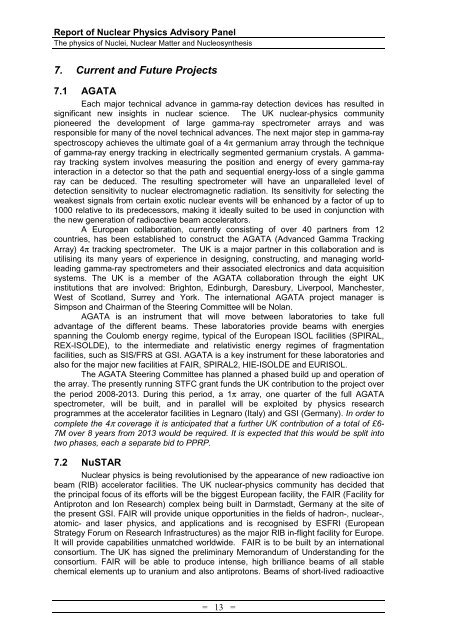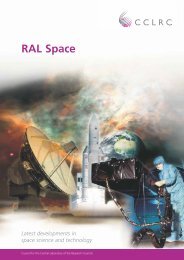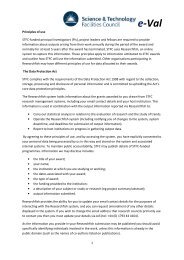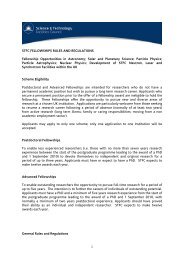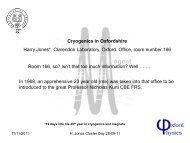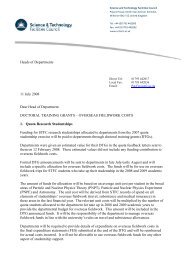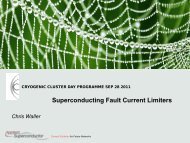Nuclear Physics Advisory Panel (NPAP) report (PDF-3.8 MB) - STFC
Nuclear Physics Advisory Panel (NPAP) report (PDF-3.8 MB) - STFC
Nuclear Physics Advisory Panel (NPAP) report (PDF-3.8 MB) - STFC
You also want an ePaper? Increase the reach of your titles
YUMPU automatically turns print PDFs into web optimized ePapers that Google loves.
Report of <strong>Nuclear</strong> <strong>Physics</strong> <strong>Advisory</strong> <strong>Panel</strong><br />
The physics of Nuclei, <strong>Nuclear</strong> Matter and Nucleosynthesis<br />
7. Current and Future Projects<br />
7.1 AGATA<br />
Each major technical advance in gamma-ray detection devices has resulted in<br />
significant new insights in nuclear science. The UK nuclear-physics community<br />
pioneered the development of large gamma-ray spectrometer arrays and was<br />
responsible for many of the novel technical advances. The next major step in gamma-ray<br />
spectroscopy achieves the ultimate goal of a 4π germanium array through the technique<br />
of gamma-ray energy tracking in electrically segmented germanium crystals. A gammaray<br />
tracking system involves measuring the position and energy of every gamma-ray<br />
interaction in a detector so that the path and sequential energy-loss of a single gamma<br />
ray can be deduced. The resulting spectrometer will have an unparalleled level of<br />
detection sensitivity to nuclear electromagnetic radiation. Its sensitivity for selecting the<br />
weakest signals from certain exotic nuclear events will be enhanced by a factor of up to<br />
1000 relative to its predecessors, making it ideally suited to be used in conjunction with<br />
the new generation of radioactive beam accelerators.<br />
A European collaboration, currently consisting of over 40 partners from 12<br />
countries, has been established to construct the AGATA (Advanced Gamma Tracking<br />
Array) 4π tracking spectrometer. The UK is a major partner in this collaboration and is<br />
utilising its many years of experience in designing, constructing, and managing worldleading<br />
gamma-ray spectrometers and their associated electronics and data acquisition<br />
systems. The UK is a member of the AGATA collaboration through the eight UK<br />
institutions that are involved: Brighton, Edinburgh, Daresbury, Liverpool, Manchester,<br />
West of Scotland, Surrey and York. The international AGATA project manager is<br />
Simpson and Chairman of the Steering Committee will be Nolan.<br />
AGATA is an instrument that will move between laboratories to take full<br />
advantage of the different beams. These laboratories provide beams with energies<br />
spanning the Coulomb energy regime, typical of the European ISOL facilities (SPIRAL,<br />
REX-ISOLDE), to the intermediate and relativistic energy regimes of fragmentation<br />
facilities, such as SIS/FRS at GSI. AGATA is a key instrument for these laboratories and<br />
also for the major new facilities at FAIR, SPIRAL2, HIE-ISOLDE and EURISOL.<br />
The AGATA Steering Committee has planned a phased build up and operation of<br />
the array. The presently running <strong>STFC</strong> grant funds the UK contribution to the project over<br />
the period 2008-2013. During this period, a 1π array, one quarter of the full AGATA<br />
spectrometer, will be built, and in parallel will be exploited by physics research<br />
programmes at the accelerator facilities in Legnaro (Italy) and GSI (Germany). In order to<br />
complete the 4π coverage it is anticipated that a further UK contribution of a total of £6-<br />
7M over 8 years from 2013 would be required. It is expected that this would be split into<br />
two phases, each a separate bid to PPRP.<br />
7.2 NuSTAR<br />
<strong>Nuclear</strong> physics is being revolutionised by the appearance of new radioactive ion<br />
beam (RIB) accelerator facilities. The UK nuclear-physics community has decided that<br />
the principal focus of its efforts will be the biggest European facility, the FAIR (Facility for<br />
Antiproton and Ion Research) complex being built in Darmstadt, Germany at the site of<br />
the present GSI. FAIR will provide unique opportunities in the fields of hadron-, nuclear-,<br />
atomic- and laser physics, and applications and is recognised by ESFRI (European<br />
Strategy Forum on Research Infrastructures) as the major RIB in-flight facility for Europe.<br />
It will provide capabilities unmatched worldwide. FAIR is to be built by an international<br />
consortium. The UK has signed the preliminary Memorandum of Understanding for the<br />
consortium. FAIR will be able to produce intense, high brilliance beams of all stable<br />
chemical elements up to uranium and also antiprotons. Beams of short-lived radioactive<br />
= 13 =


